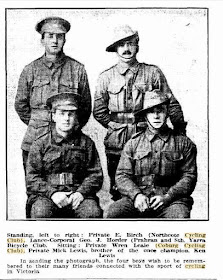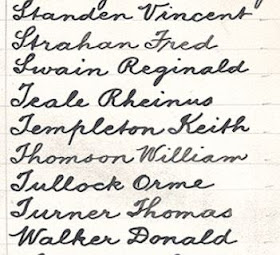This entry started with a photograph of a house in Sydney Road and the stories that I've collected relating to it.
Cement House corner. Carr. St. and Sydney Road, Coburg, 13 October 1968. Photographer John T. Collins. Image H94.200966. Courtesy State LIbrary of Victoria.
The photograph was taken from Carr Street. The building on the left is a small outbuilding and the house is in the background. It was built in the 1920s for (or maybe by) Alexander Sutherland, a Scotsman who had settled in Coburg in the early 1890s. His address from 1922 was 570 Sydney Road, Coburg and when the street numbers changed in 1925/26, it became 726 Sydney Road.
It's now the site of the Coburg Motor Inn, but in the 1920s it must have stood out from the crowd - there were not many cement houses in Coburg.
Here's how it looks on Melbourne Metropolitan Board of Works detail plan 3533 (from the State Library of Victoria's digitised collection of MMBW detail plans) in 1930. It might give you a better idea of the house's situation. You can see the outbuilding on the Carr Street fenceline and the house behind it and off the street. Sydney Road is at the bottom of the plan (so to the west) and Merri Creek is at the top (to the east).
My interest was piqued by these comments from a family member: 'I believe it was one of the earliest concrete houses built and its roof used old cable-car wires for reinforcing a sort-of-domed roof. It had a veranda on two sides with pillars.' This family member thought that the brick building on the left was an old dairy.
The family member wrote about the inside of the house, too: 'I remember the upstairs, which had a central bedroom on a very slightly higher floor than the children's bedrooms which encircled it and those rooms had walls that did not reach the ceiling. The reason for that was to provide light and air to the central parents' room and to allow the parents to look over the walls to check on the children, who because of their relatively lower floors could not do the same thing and check on their parents. Of course I remember that - what kid wouldn't?'
And not too long ago I was told about the house from an out of towner who used to visit Coburg relatives as a child and her father always drove them past 'the cement house that they always called the mushroom house – or the fairy house.'
Alexander Sutherland's wife Annie died in 1933 and he died the following year but their unmarried children James (Jim), who worked for the State Savings Bank and Elizabeth (Bessie), a State School teacher then Superintendent of the Brighton Orphanage, lived on in the house until James's death in 1960. (Elizabeth died at Brighton in 1974).
It was the image of Jim Sutherland standing on his ladder and trimming the huge cypress hedge that caught my attention and when I realised he was of an age to have served in the First World War, I went back to my research and sure enough, there he was, 40 Quarter Master Sergeant James Bain Sutherland, 8th Light Horse Regiment, A Squadron.
He had enlisted at Wodonga where he was the manager of the Wodonga branch of the State Savings bank. He was 29 years old and gave his father Alexander, of Bell Street, Coburg, as his next of kin.
James Sutherland enlisted on 14 September 1914 and embarked on 25 September 1915 aboard the HMAT A16 Star of Victoria. There were a number of other Coburg men aboard the troopship, including 2845 Signaller Lance-Corporal Thomas Atherton Johnston (KIA 15 July 1916, France), 2864 Private Thomas Oscar Meredith (KIA 19 August 1916, France), 2849 Private Albert Harrison Lee, 2876 Private Arthur Clarence Bloom and 2961 Private John William Davis. Like James Sutherland, all these young men were old boys of Coburg State School and Johnston and Meredith are featured in the book I wrote in 2017 - The old boys of Coburg State School go to war (available for purchase from Coburg Historical Society).
Sutherland began his service as a Private by was RQM Sergeant by November 1914. He contracted influenza in Egypt on arrival and again on Gallipoli. He was based in Cairo and went to the School of Instruction in January 1916.
In May 1916 he was transferred to the 59th Battalion and set off for France where he was promoted to 2nd Lieutenant in August 1916 and then to Lieutenant in February 1917. He was wounded in the left knee in June 1918 and transferred to England but was back on duty in August. He returned to Australia on 24 December 1918, having been granted Special Leave (Anzac Leave) as an soldier who began his service in 1914 and had served continuously from that time.
On his return, he rejoined his family and moved with them to the 'cement' house in the 1920s where he lived until his death in 1960 aged 74.















